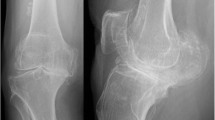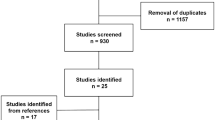Abstract
Purpose
The aim of this study was to evaluate femoral and tibial as well as whole leg coronal TKA alignment using 3D-reconstructed CTs and to assess the relationship of coronal TKA alignment and clinical outcome in a large prospective series of patients. It was hypothesized that a coronal deviation of TKA position and leg alignment from the mechanical axis is correlated with poorer patients’ outcome after TKA.
Methods
A total of 81 consecutive patients who underwent primary TKA were prospectively included. The patient’s demographics such as age, gender and time from primary TKA were noted. All patients underwent clinical and radiological examination including standardized radiographs (anteroposterior and lateral weight-bearing, patellar skyline view) and CT as part of their postoperative follow-up. For assessment of TKA component position and orientation 3D-reconstructed CT was used. For clinical outcome scoring the Knee Society Score (KSS) was used at 1 and 2 years postoperatively. Linear and quadratic regression models were used to test for correlations between alignment variables and KSS (p < .05).
Results
The mean Knee Society Score was 181 ± 28 (range 52–200) 2 years postoperatively, while 78% of the patients were completely pain free and 22% had some persisting pain interfering with their daily activities. The mean mechanical whole limb alignment (HKA angle), femoral component alignment and tibial component alignment were 0°, 0.1° and −0.7°, respectively. The component position parameters, as well as the whole limb alignment measurements, did not show any statistically significant correlation with the KSS, after 1 and 2 years postoperatively.
Conclusion
In this prospective study, using 3D-CT to measure the component position, the postoperative outcome was not influenced by coronal TKA component position as well as the whole leg alignment. The findings challenge the current target of neutral coronal alignment and point towards a more individualized mechanical alignment target.
Level of evidence
Prognostic study, Level I.






Similar content being viewed by others
References
Abdel MP, Oussedik S, Parratte S, Lustig S, Haddad FS (2014) Coronal alignment in total knee replacement: historical review, contemporary analysis, and future direction. Bone Joint J 96–B:857–862
Anderl W, Pauzenberger L, Kölblinger R, Kiesselbach G, Brandl G, Laky B, Kriegleder B, Heuberer P, Schwameis E (2016) Patient-specific instrumentation improved mechanical alignment, while early clinical outcome was comparable to conventional instrumentation in TKA. Knee Surg Sports Traumatol Arthrosc 24:102–111
Becker R, Döring C, Denecke A, Brosz M (2011) Expectation, satisfaction and clinical outcome of patients after total knee arthroplasty. Knee Surg Sports Traumatol Arthrosc 19:1433–1441
Bellemans J, Colyn W, Vandenneucker H, Victor J (2012) The Chitranjan Ranawat award: is neutral mechanical alignment normal for all patients? The concept of constitutional varus. Clin Orthop Relat Res 470:45–53
Blakeney WG, Khan RJK, Palmer JL (2014) Functional outcomes following total knee arthroplasty: a randomised trial comparing computer-assisted surgery with conventional techniques. Knee 21:364–368
Bonner TJ, Eardley WG, Patterson P, Gregg PJ (2011) The effect of post-operative mechanical axis alignment on the survival of primary total knee replacements after a follow-up of 15 years. J Bone Joint Surg Br 93:1217–1222
Choong PF, Dowsey MM, Stoney JD (2016) Does accurate anatomical alignment result in better function and quality of life? Comparing conventional and computer-assisted total knee arthroplasty. J Arthroplasty 24:560–569
D’Lima DD, Chen PC, Colwell CWJ (2001) Polyethylene contact stresses, articular congruity, and knee alignment. Clin Orthop Relat Res 392:232–238
Dossett HG, Estrada NA, Swartz GJ, LeFevre GW, Kwasman BG (2014) A randomised controlled trial of kinematically and mechanically aligned total knee replacements. Bone Joint J 96–B:907–913
Fang DM, Ritter MA, Davis KE (2009) Coronal alignment in total knee arthroplasty. J Arthroplasty 24:39–43
Gromov K, Korchi M, Thomsen MG, Husted H, Troelsen A (2014) What is the optimal alignment of the tibial and femoral components in knee arthroplasty? Acta Orthop 85:480–487
Hirschmann MT, Konala P, Amsler F, Iranpour F, Friederich NF, Cobb JP (2011) The position and orientation of total knee replacement components: a comparison of conventional radiographs, transverse 2D-CT slices and 3D-CT reconstruction. J Bone Joint Surg Br 93:629–633
Huijbregts HJTAM, Khan RJK, Fick DP, Jarrett OM, Haebich S (2016) Prosthetic alignment after total knee replacement is not associated with dissatisfaction or change in Oxford Knee Score. Knee 23:535–539
Insall JN, Dorr LD, Scott RD, Scott WN (1989) Rationale of the Knee Society clinical rating system. Clin Orthop Relat Res 248:13–14
Lieberman JR, Dorey F, Shekelle P, Schumacher L, Thomas BJ, Kilgus DJ, Finerman GA (1996) Differences between patients’ and physicians’ evaluations of outcome after total hip arthroplasty. J Bone Joint Surg Am 78:835–838
Liow RY, Walker K, Wajid MA, Bedi G, Lennox CM (2000) The reliability of the American Knee Society Score. Acta Orthop 71:603–608
Longstaff LM, Sloan K, Stamp N, Scaddan M, Beaver R (2009) Good alignment after total knee arthroplasty leads to faster rehabilitation and better function. J Arthroplasty 24:570–578
Lotke PA, Ecker ML (1977) Influence of positioning of prosthesis in total knee replacement. J Bone Joint Surg 59:77–79
Manjunath KS, Gopalakrishna KG, Vineeth G (2015) Evaluation of alignment in total knee arthroplasty: a prospective study. Eur J Orthop Surg Traumatol 25:895–903
Matsuda S, Kawahara S, Okazaki K, Tashiro Y, Iwamoto Y (2013) Postoperative alignment and ROM affect patient satisfaction after TKA knee. Clin Orthop Relat Res 471:127–133
Matziolis G, Adam J, Perka C (2010) Varus malalignment has no influence on clinical outcome in midterm follow-up after total knee replacement. Arch Orthop Trauma Surg 130:1487–1491
Mugnai R, Zambianchi F, Digennaro V, Marcovigi A, Tarallo L, Del Giovane C, Catani F (2016) Clinical outcome is not affected by total knee arthroplasty alignment. Knee Surg Sports Traumatol Arthrosc. doi:10.1007/s00167-016-4094-1
Parratte S, Pagnano MW, Trousdale RT, Berry DJ (2010) Effect of postoperative mechanical axis alignment on the fifteen-year survival of modern, cemented total knee replacements. J Bone Joint Surg Am 92:2143–2149
Rasch H, Falkowski AL, Forrer F, Henckel J, Hirschmann MT (2013) 4D-SPECT/CT in orthopaedics: a new method of combined quantitative volumetric 3D analysis of SPECT/CT tracer uptake and component position measurements in patients after total knee arthroplasty. Skelet Radiol 42:1215–1223
Schiraldi M, Bonzanini G, Chirillo D, de Tullio V (2016) Mechanical and kinematic alignment in total knee arthroplasty. Ann Transl Med 4(7):130–135
Scott CEH, Howie CR, MacDonald D, Biant LC (2010) Predicting dissatisfaction following total knee replacement: a prospective study of 1217 patients. J Bone Joint Surg Br 92:1253–1258
Sikorski JM (2008) Alignment in total knee replacement. J Bone Joint Surg Br 90:1121–1127
Skytta ET, Lohman M, Tallroth K, Remes V (2009) Comparison of standard anteroposterior knee and hip-to-ankle radiographs in determining the lower limb and implant alignment after total knee arthroplasty. Scand J Surg 98:250–253
Vanlommel L, Vanlommel J, Claes S, Bellemans J (2013) Slight undercorrection following total knee arthroplasty results in superior clinical outcomes in varus knees. Knee Surg Sports Traumatol Arthrosc 21:2325–2330
Wagner CR, Hirschmann MT, Beasley RA (2015) Specific orthopaedic imaging analysis software: clinical benefit fro TKR revision surgeon. In: Hirschmann MT, Becker R (eds) The unhappy total knee replacement: a comprehensive review and management guide. Berlin, Heidelberg, Munich, Neu-Isenburg, Vienna, pp 69–83
Zhang G, Chen J, Chai W, Liu M, Wang Y (2011) Comparison between computer-assisted-navigation and conventional total knee arthroplasties in patients undergoing simultaneous bilateral procedures. J Bone Joint Surg Am 93:1190–1196
Authors’ contributions
OS carried out the CT measurements, participated in analysis of results and drafted the manuscript. FA participated in the design of the study and performed the statistical analysis. MTH designed and set up the study design, helped to analyse the data and draft the manuscript. All authors read and approved the final manuscript.
Author information
Authors and Affiliations
Corresponding author
Ethics declarations
Conflict of interest
The author(s) declare that they have no competing interests.
Funding
There was no funding from any company of institutional foundation given for this study. There is no financial conflict here.
Ethical approval
Ethical approval was obtained from the Ethics Committee of Northwestern and Central Switzerland (EKNZ 2015-448). All procedures performed were in accordance with the ethical standards of the institutional and/or national research committee and with the 1964 Declaration of Helsinki and its later amendments or comparable ethical standards.
Informed consent
Informed consent was obtained from all individual participants included in the study.
Rights and permissions
About this article
Cite this article
Slevin, O., Amsler, F. & Hirschmann, M.T. No correlation between coronal alignment of total knee arthroplasty and clinical outcomes: a prospective clinical study using 3D-CT. Knee Surg Sports Traumatol Arthrosc 25, 3892–3900 (2017). https://doi.org/10.1007/s00167-016-4400-y
Received:
Accepted:
Published:
Issue Date:
DOI: https://doi.org/10.1007/s00167-016-4400-y




